Mì vịt tiềm (Vietnamese duck noodle soup) is a one-of-a-kind dish that packs a ton of flavor. It features a rich and dark broth, which is infused with various herbs and veggies from traditional Chinese medicine, and fall-off-the-bone duck legs.
Therefore, mì vịt tiềm is a totally different story compared to other noodle soup dishes from Vietnam, such as phở or bún mọc. This heath-giving dish is an explosion of flavors that’ll wow you right after the first spoonful!
Mì Vịt Tiềm – When Folk Medicine Meets Cookery
Mì vịt tiềm is a creation of the Chinese people living in Saigon in the 90s. Although many believed the recipe was brought from China to Vietnam, some credible sources state that it wasn’t a part of traditional Chinese cuisine.
Whatever the case is, mì vịt tiềm has long been a popular dish among the Saigonese in the Southern part of Vietnam. The dish captivates foodies with its special broth made from a collection of traditional medicinal herbs. In addition, the cook would roast or deep-fried the duck legs before simmering them in said broth.
The final dish is a perfect combination of incredibly aromatic, uniquely-flavored dark broth with tender, spice-infused duck legs. Though simple, the egg noodles are the cherry on top that ties everything together, creating a culinary experience you’ll never forget.
Cooking Tools for Mì Vịt Tiềm
First, prepare the tools listed below.
Ingredients in Mì Vịt Tiềm
I have to admit that the ingredient list for mì vịt tiềm is quite long, especially in the herbs department. You’ll most likely need to visit an Asian store to find these herbs and vegetables.
However, it’s totally fine if you can’t get all of them! Just try your best to gather as many as possible.
Medicinal Herbs and Vegetables
Directions to Cook Mì Vịt Tiềm
Here comes the main part. Let’s make a healthy and tasty bowl of Vietnamese duck noodle soup!
Step 1: Prepare The Ingredients
Soak the dried shiitake mushrooms in water for about 30 minutes.
Mince the shallot and garlic.
Rinse the bok choy and cut them in half.
Peel and rinse the lotus root. Then, cut it into slices.
Julienne the scallions and soak them in cold water. You can also chop the scallions into pieces.
Wash the red dates, black jujubes, and goji berries thoroughly. Then, soak them in cold water.
Step 2: Marinate The Duck Legs
Season the duck with
Massage the duck legs with your hands to help them absorb the spices better, and marinate for about 10 to 15 minutes. If you have time, put them in the fridge for 1 hour (ideally 3 to 4 hours). In the meantime, move on to the next steps.
Step 3: Prepare The Medicinal Herbs
Add all the medicinal herbs, except the monk fruit and sheng di huang, to a heated pan and roast them over medium heat. Once done, put them into a soup bag.
Crush the monk fruit with your hands and put it into another soup bag. Likewise, put the Sheng Di Huang in a separate soup bag.
Step 4: Roast The Duck
Preheat the oven to 392°F (200°C) for 10 minutes.
Line a baking tray with aluminum foil and place the marinated duck legs on it. Roast the duck for 15 minutes at 392°F.
Next, turn the legs over so that the skin sides face up. Brush the skin with a little dark soy sauce to give them a more appetizing color.
Then, roast the duck for another 15 minutes.
Step 5: Cook The Broth
Pour the chicken bone broth into the stock pot. Then, add the prepared spice bags and the roasted ducks. Stew the duck over medium heat for about 15 minutes.
After the 15-minute mark, add the shiitake mushrooms, red dates, goji berries, black jujubes, and lotus roots to the pot.
Continue to stew for another 45 minutes on medium heat. You might need to adjust the cooking time depending on the size of the duck legs.
Then, remove all the herbs and spices from the pot.
Add about 8.5 cups (2 liters) of boiled water.
Simmer the broth for another 1 hour.
Afterward, season the broth with 1.5 teaspoons of sugar, 1 tablespoon of salt, and 1 tablespoon of soy sauce.
Give the broth a good stir.
Step 6: Blanch The Noodles And Bok Choy
Bring a pot of water to a boil. Blanch the noodles, then transfer them to a bowl of cold water. Drain the noodles and put them on a plate.
Likewise, blanch the bok choy in boiled water and place them in a cold water bath. Keep them in cold water to maintain their crispness and color. Only drain them when you’re about to serve the dish.
Step 7: Present The Dish
Roll the noodles and put them in a bowl. Arrange the roasted duck, shiitake mushrooms, lotus roots, red dates, black jujubes, goji berries, and bok choy over the noodles. Add the sliced scallions and pour in the broth. Sprinkle some ground pepper on top.
You can add soy sauce, chili peppers, lime juice, or chili salt to your mì vịt tiềm to enhance its flavor.
Ideal Tips for Mì Vịt Tiềm
There are a few tips you can apply while cooking to make your mì vịt tiềm taste the best. Check them out!
Vietnamese Duck Noodle – A Healthy and Tasty Recipe
Vietnamese duck noodle soup brings various health benefits while being an incredibly fragrant and flavor-packed dish. The combination of traditional herbs and fatty duck meat creates a rich and hearty noodle soup that’s unique to Vietnamese cuisine.
Give this special dish a try, and let me know what you think about it in the comment section. If you find today’s recipe yummy, please drop a like and share it with your fellow home cooks. Don’t forget to also check out other tasty recipes on the website!

Mì Vịt Tiềm Recipe (Vietnamese Duck Noodle Soup)
Equipment
- Pot
- Sieve
- Pan
- Spatula
- Oven
- Baking tray
- Aluminum Foil
- Knife
- Chopping Board
- Bowl
- Basting Brush
- Kitchen chopsticks
Ingredients
- 1.3 pounds of egg noodles
- 4.5 cups bone broth
- 1.8 ounces of dried shiitake mushrooms, soaked
- 8.8 ounces lotus root
- 10.5 ounces bok choy
- 0.7 ounces scallions
- 2 large quarter duck leg quarters (about 1.3 pounds each)
For the marinade
- 0.7 ounces garlic
- 0.7 ounces shallots
- 1 tablespoon soy sauce
- 1 teaspoon salt
- 1.5 teaspoons sugar
- 1 tablespoon oyster sauce
- 1 tablespoon sesame oil
- 1 tablespoon dark soy sauce
- 1 tablespoon pepper
- 1 tablespoon five-spice powder
For seasoning the broth
- 1 tablespoon soy sauce
- 1 tablespoon salt
- 1.5 teaspoons sugar
Medicinal herbs
- 0.35 ounces huai shan (dried Chinese yam)
- 0.18 ounces dang gui (angelica root)
- 0.18 ounces dang shen (codonopsis root)
- 0.1 ounces chuan ziong (Szechuan lovage root
- 0.18 ounces of star anise
- 0.3 ounces of cinnamon bark
- 2 black cardamom pods
- 0.35 ounces cloves
- 1.8 ounces hong zao (jujubes or red dates)
- 0.7 ounces da zao (black jujubes)
- 1.8 ounces gou qi zi (goji berries)
- 0.5 teaspoons dried tangerine peel
- 0.3 ounces licorice
- 0.18 ounces dried ginger
- 1 luohan guo (monk fruit)
- 0.18 ounces du zhong (Chinese rubber tree bark)
- 0.1 ounces bai zhi (Dahurian angelica root)
- 0.5 ounces coriander seeds
- 0.3 ounces fennel seeds
- 0.3 ounces sheng di huang
Instructions
- Soak the dried shiitake mushrooms in water for about 30 minutes.Mince the shallot and garlic.
- Rinse the bok choy and cut them in half. Peel and rinse the lotus root. Then, cut it into slices.Julienne the scallions and soak them in cold water.
- Wash the red dates, black jujubes, and goji berries thoroughly. Then, soak them in cold water.
- Season the duck with garlic, shallot, oyster sauce, sugar, salt, pepper, dark soy sauce, sesame oil, soy sauce, and five-spice powder.
- Massage the duck legs and marinate for about 10 to 15 minutes.
- Add all the medicinal herbs, except the monk fruit and sheng di huang, to a heated pan and roast them over medium heat.Once done, put them into a soup bag.Crush the monk fruit with your hands and put it into another soup bag. Put the sheng di huang in a separate soup bag.
- Preheat the oven to 392°F for 10 minutes. Place the marinated duck legs on a tray lined with aluminum foil.Roast the duck for 15 minutes at 392°F.
- Turn the legs over so that the skin sides face up. Brush the skin with a little dark soy sauce.
- Roast the duck for another 15 minutes.
- Pour the chicken bone broth into the stock pot. Add the prepared spice bags and the roasted ducks.Stew the duck over medium heat for about 15 minutes.
- Next, add the shiitake mushrooms, red dates, goji berries, black jujubes, and lotus roots.
- Continue to stew for another 45 minutes on medium heat.
- Then, remove all the herbs and spices from the pot.
- Add about 8.5 cups of boiled water.
- Simmer the broth for another 1 hour.
- Afterward, season the broth with sugar, salt, and soy sauce.
- Give the broth a good stir.
- Blanch the noodles, then transfer them to a bowl of cold water. Drain the noodles and put them on a plate.
- Blanch the bok choy in boiled water and place them in a cold water bath. Drain them when you’re about to serve the dish.
- Roll the noodles and put them in a bowl.Arrange the roasted duck, shiitake mushrooms, lotus roots, red dates, black jujubes, goji berries, and bok choy over the noodles.Add the sliced scallions and pour in the broth. Sprinkle some ground pepper on top. Enjoy!
Video
Notes
- The estimated total time is for making 4 servings.
- If you can’t find all the listed medicinal herbs, try your best to get the following: clove, star anise, cinnamon, and licorice.
- You should skim the broth frequently during cooking to keep it clear.
- If you don’t own an oven, you can deep fry the duck instead.
- Skim off most of the duck fat to prevent the dish from being greasy.
- Always put the herbs and spices into soup bags so you can remove them from the pot easier and have a smoother broth.



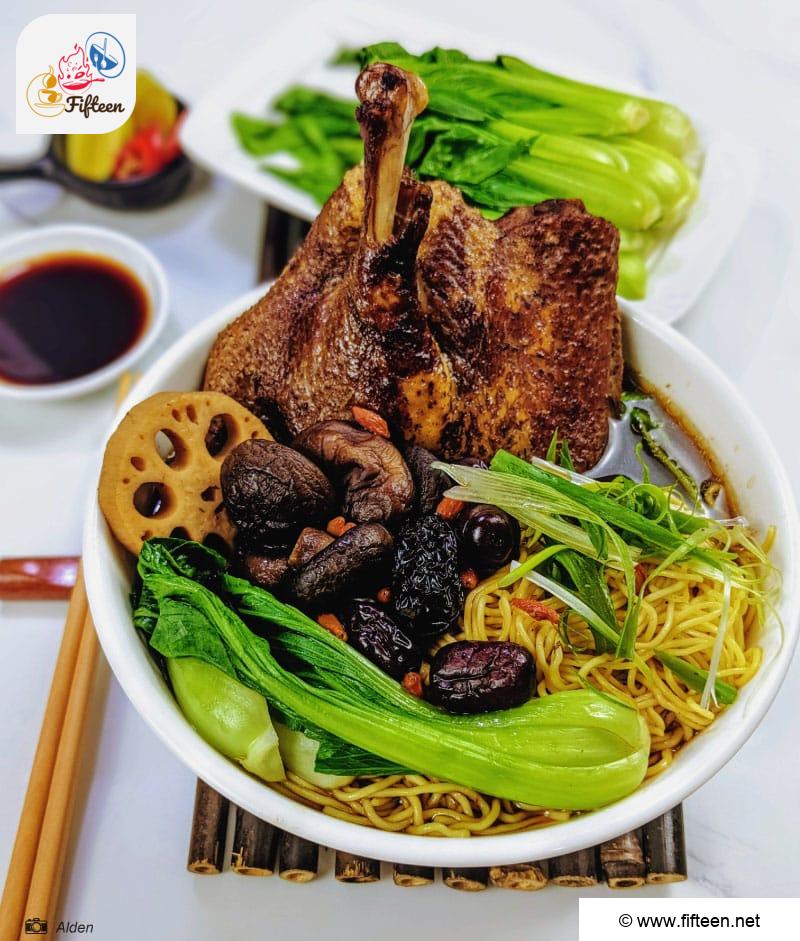





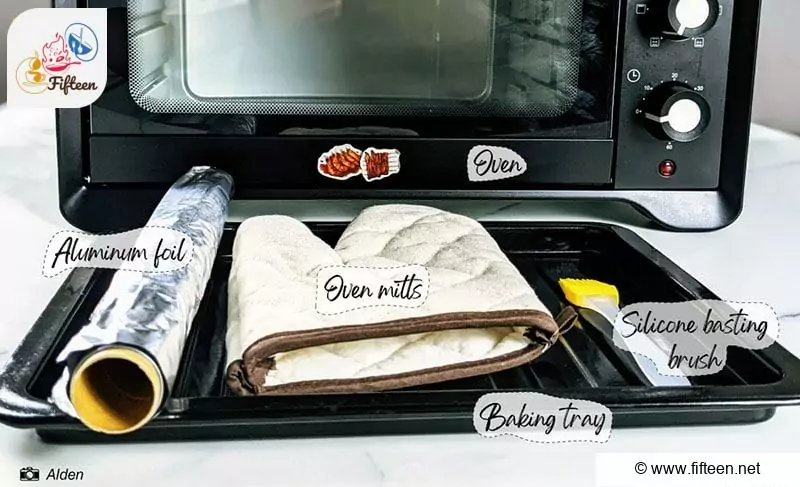








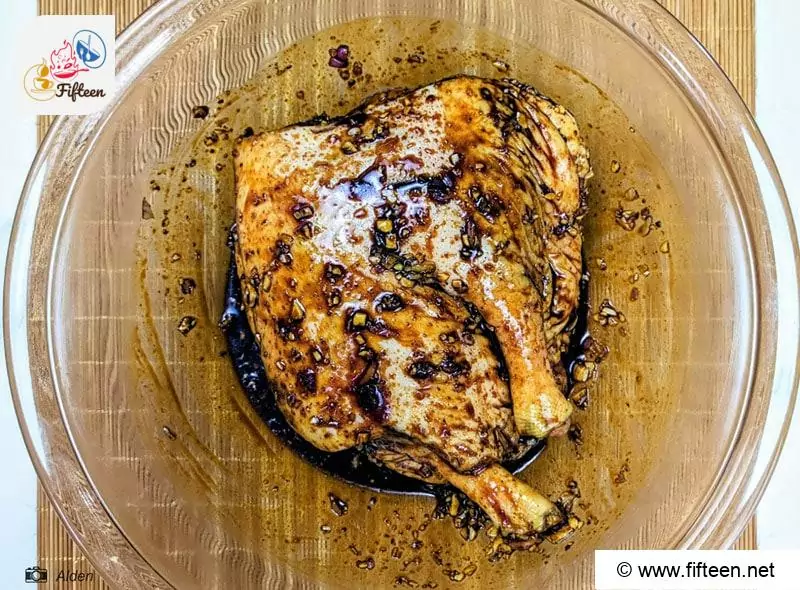

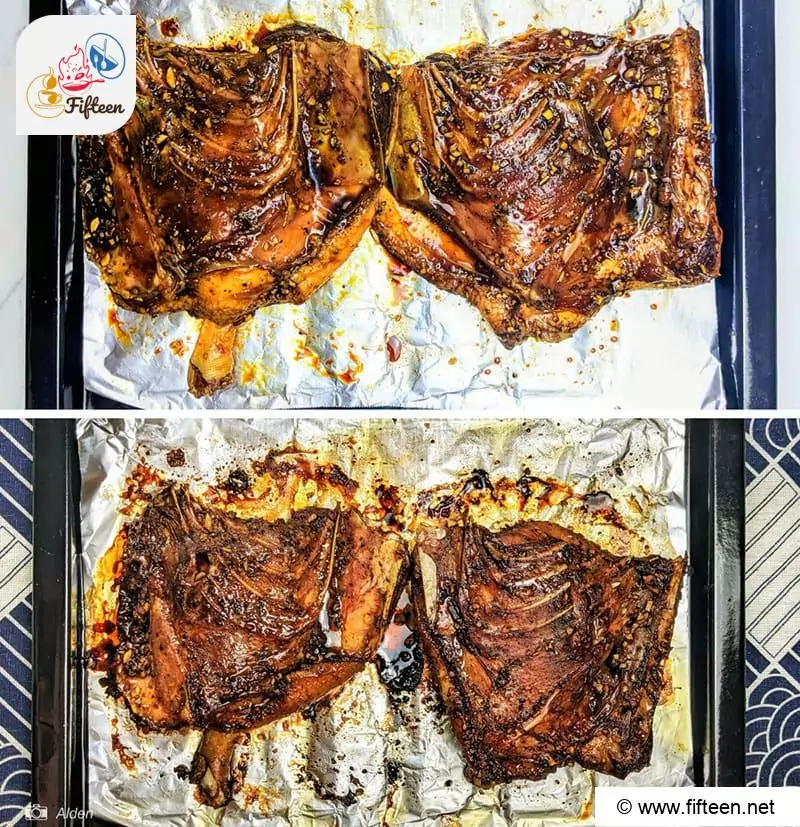








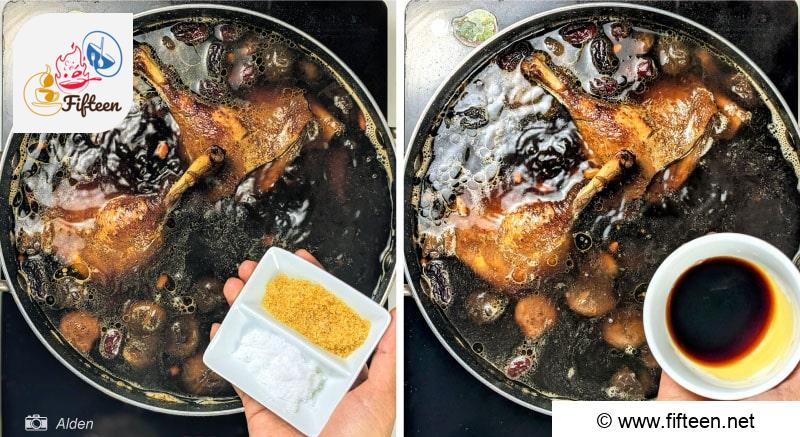





Hi Jamie, amazing recipe! Currently bubbling away on the stove and hubby very much looking forward to his amazing smelling dinner! Can I make the recommendation that you tweak the summarised recipe to include quantities going in the duck marinade? I made the mistake of putting 1.5 tablespoons of salt on the duck as it said to add the salt but further up in the commentary apparently it’s only 1.5 teaspoons! Also the recipe down the bottom does not include the final steps of salt, sugar and soy sauce. Can you split these amounts out to reflect what goes in marinade vs the end optional to taste? Also ingredients call for 2 tablespoons of sugar but up the top only 1 is used at the very end. Not sure where the other tablespoon is meant to go. Same with soy sauce. I put 2 tablespoons in the marinade and didn’t realise only 1 should go in and 1 reserved for final taste balancing. Thankfully it’s not too salty even with the mistake on the marinade. I think I’m saved as I used low sodium soy sauce. Honestly the monk fruit makes it so sweet I think sugar can be omitted completely. Looking forward to dinner and making this many more times!!!
Hi Tania, thank you for the kind words and your feedback! I have updated the summarised recipe and separated the ingredients used for the marinade and the broth into 2 parts. Hope this will help. Also, I’ve made some adjustments to the quantity of sugar. To clear things up, you should add 1.5 teaspoons of sugar to the marinade and 1.5 teaspoons to the broth. Personally, I like my food a little bit on the sweet side, so I usually season the broth with a bit more sugar. Of course, if you find the soup too sweet, feel free to reduce the amount of sugar. Again, thank you for trying out the recipe, and I wish you and your loved ones a great meal!